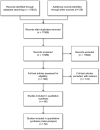Longitudinal outcome evaluations of Interdisciplinary Multimodal Pain Treatment programmes for patients with chronic primary musculoskeletal pain: A systematic review and meta-analysis
- PMID: 34624159
- PMCID: PMC9297911
- DOI: 10.1002/ejp.1875
Longitudinal outcome evaluations of Interdisciplinary Multimodal Pain Treatment programmes for patients with chronic primary musculoskeletal pain: A systematic review and meta-analysis
Abstract
Background and objectives: Although Interdisciplinary Multimodal Pain Treatment (IMPT) programmes share a biopsychosocial approach to increase the wellbeing of patients with chronic pain, substantial variation in content and duration have been reported. In addition, it is unclear to what extent any favourable health outcomes are maintained over time. Therefore, our first aim was to identify and analyse the change over time of patient-related outcome measures in cohorts of patients who participated in IMPT programmes. Our second aim was to acquire insight into the heterogeneity of IMPT programmes.
Databases and data treatment: The study protocol was registered in Prospero under CRD42018076093. We searched Medline, Embase, PsycInfo and Cinahl from inception to May 2020. All study selection, data extraction and risk of bias assessments were independently performed by two researchers. Study cohorts were eligible if they included adult patients with chronic primary musculoskeletal pain for at least 3 months. We assessed the change over time, by calculating pre-post, post-follow-up and pre-follow-up contrasts for seven different patient-reported outcome domains. To explore the variability between the IMPT programmes, we summarized the patient characteristics and treatment programmes using the intervention description and replication checklist.
Results: The majority of the 72 included patient cohorts significantly improved during treatment. Importantly, this improvement was generally maintained at follow-up. In line with our expectations and with previous studies, we observed substantial methodological and statistical heterogeneity.
Conclusions: This study shows that participation in an IMPT programme is associated with considerable improvements in wellbeing that are generally maintained at follow-up. The current study also found substantial heterogeneity in dose and treatment content, which suggests different viewpoints on how to optimally design an IMPT programme.
Significance: The current study provides insight into the different existing approaches regarding the dose and content of IMPT programs. This analysis contributes to an increased understanding of the various approaches by which a biopsychosocial perspective on chronic pain can be translated to treatment programs. Furthermore, despite theoretical and empirical assertions regarding the difficulty to maintain newly learned health behaviors over time, the longitudinal analysis of health outcomes did not find a relapse pattern for patients who participated in IMPT programs.
© 2021 The Authors. European Journal of Pain published by John Wiley & Sons Ltd on behalf of European Pain Federation - EFIC ®.
Conflict of interest statement
There is no conflict of interest.
Comment in
-
Commentary on Elbers et al. "Longitudinal outcome evaluations of IMPT programs".Eur J Pain. 2022 Feb;26(2):280-281. doi: 10.1002/ejp.1888. Epub 2021 Nov 18. Eur J Pain. 2022. PMID: 34748259 No abstract available.
References
-
- Abbasi, M. , Dehghani, M. , Keefe, F. J. , Jafari, H. , Behtash, H. , & Shams, J. (2012). Spouse‐assisted training in pain coping skills and the outcome of multidisciplinary pain management for chronic low back pain treatment: A 1‐year randomized controlled trial. European Journal of Pain, 16(7), 1033–1043. 10.1002/j.1532-2149.2011.00097.x - DOI - PubMed
-
- Balk, E. M. , Earley, A. , Patel, K. , Trikalinos, T. A. , & Dahabreh, I. J. (2012). In Empirical assessment of within‐arm correlation imputation in trials of continuous outcomes (methods research report no. AHRQ publication no. 12 (13)‐EHC141‐EF). Agency for Healthcare Research and Quality. Retrieved April 2, 2020, from https://www.ncbi.nlm.nih.gov/books/NBK115797/pdf/Bookshelf_NBK115797.pdf - PubMed
-
- Bannach‐Brown, A. , Przybyła, P. , Thomas, J. , Rice, A. S. C. , Ananiadou, S. , Liao, J. , & Macleod, M. R. (2019). Machine learning algorithms for systematic review: Reducing workload in a preclinical review of animal studies and reducing human screening error. Systematic Reviews, 8(1), 23. 10.1186/s13643-019-0942-7 - DOI - PMC - PubMed
-
- Beaudreuil, J. , Kone, H. , Lasbleiz, S. , Vicaut, E. , Richette, P. , Cohen‐Solal, M. , Lioté, F. , de Vernejoul, M. C. , Nizard, R. , Yelnik, A. , Bardin, T. , & Orcel, P. (2010). Efficacy of a functional restoration program for chronic low back pain: Prospective 1‐year study. Joint Bone Spine, 77(5), 435–439. 10.1016/j.jbspin.2010.03.003 - DOI - PubMed
Publication types
MeSH terms
LinkOut - more resources
Full Text Sources
Medical


